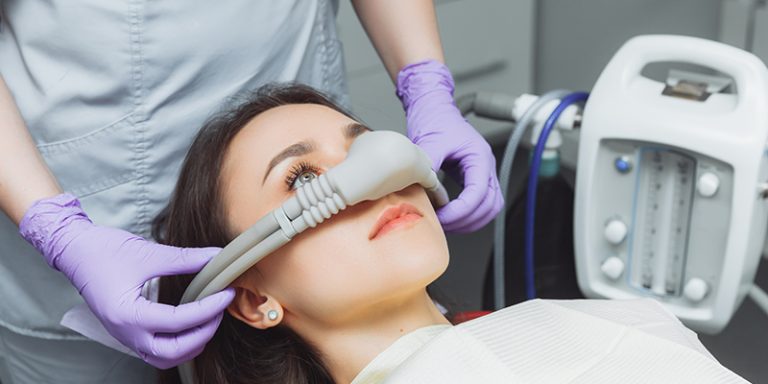
Sedation Dentistry
Sedation dentistry is a valuable option for patients who experience dental anxiety, fear, or discomfort during dental visits. For some individuals, the thought of a dental procedure can cause significant stress, while others may require extensive treatments that could be more manageable with a relaxed state. Sedation dentistry uses various methods to help calm patients and ensure a more comfortable, stress-free dental experience.
By using sedatives, patients can undergo procedures with minimal anxiety or discomfort, making it easier to receive necessary dental care. Sedation options are personalized based on the patient’s needs, the complexity of the procedure, and the patient’s level of anxiety.
1. Nitrous Oxide Sedation (Laughing Gas):
Nitrous oxide, commonly known as “laughing gas,” is a mild sedative administered through a mask that covers the nose. It helps patients relax during procedures, reducing anxiety and discomfort. Nitrous oxide works quickly and wears off almost immediately after the procedure is completed, allowing patients to return to their normal activities right away. It is commonly used for less invasive treatments, such as cleanings, fillings, and simple extractions, and is considered safe for most patients.
Benefits of Nitrous Oxide:
- Fast-acting and easily adjustable
- No lingering effects after treatment
- Safe for most patients, including children
- Helps with mild to moderate anxiety
2. Oral Sedation:
Oral sedation involves taking a prescribed sedative in pill form before the dental procedure. The sedative helps patients feel deeply relaxed or drowsy but still awake and able to respond to the dentist’s instructions. Oral sedation can range from minimal to moderate levels of sedation depending on the dosage, and it is suitable for patients with moderate anxiety or those undergoing longer, more involved procedures.
Benefits of Oral Sedation:
- Effective for patients with moderate anxiety
- Allows for a deeper level of relaxation
- Easy to administer through oral medication
- Suitable for more complex procedures
3. Intravenous (IV) Sedation:
IV sedation delivers medication directly into the bloodstream, allowing the dentist to control the level of sedation more precisely. This option is ideal for patients undergoing lengthy or invasive procedures, such as tooth extractions, root canals, or dental implants. Patients typically experience a deep state of relaxation and may not remember the details of the procedure afterward. IV sedation ensures that the patient remains comfortable throughout the treatment while allowing the dentist to work efficiently.
Benefits of IV Sedation:
- Deep relaxation, with no memory of the procedure
- Highly adjustable to meet the needs of each patient
- Ideal for lengthy or complex treatments
- Allows patients with severe anxiety to undergo necessary procedures comfortably
Who Can Benefit from Sedation Dentistry?
- Patients with Dental Anxiety: Sedation helps calm the nerves of those who feel overwhelmed or fearful about dental procedures.
- Patients Needing Extensive Work: Those who require multiple procedures in one visit may find sedation beneficial, as it helps them remain comfortable for longer periods.
- Patients with Sensitive Teeth: Sedation can ease discomfort for those with sensitive teeth or who experience pain during routine procedures like cleanings.
- Patients with a Strong Gag Reflex: Sedation dentistry can help reduce the gag reflex, making it easier for patients to undergo treatments such as X-rays, impressions, or fillings.
- Patients with Special Needs: Individuals who may have difficulty sitting still or staying calm during dental procedures may benefit from sedation.
Safety of Sedation Dentistry
Sedation dentistry is generally very safe when administered by a trained and experienced dentist. Before undergoing any form of sedation, a thorough consultation and evaluation are conducted to ensure that sedation is appropriate for the patient’s medical history, health status, and specific needs. In some cases, the dentist may recommend a medical evaluation to ensure the patient’s safety during the procedure.
What to Expect During Sedation Dentistry
Pre-Procedure:
Before your appointment, you’ll have a discussion with your dentist about which sedation option is best suited for you. If you’re using oral or IV sedation, you may be asked to refrain from eating or drinking for a few hours prior to the appointment.During the Procedure:
While under sedation, you will remain comfortable and relaxed throughout the treatment. The dentist will closely monitor your vital signs and adjust sedation levels if necessary to ensure your safety and comfort.After the Procedure:
Once the procedure is complete, you’ll be monitored until the effects of the sedation wear off. If you have used nitrous oxide, you can usually leave immediately. For oral or IV sedation, you may need a friend or family member to drive you home, as the effects can last for a few hours.
Advantages of Sedation Dentistry
- Reduced Anxiety and Stress: Patients experience less fear or discomfort during procedures, making dental visits more manageable.
- Pain-Free Procedures: Sedation allows for a more comfortable experience, especially during invasive treatments.
- Increased Treatment Efficiency: Patients can undergo longer or multiple procedures in one visit while remaining relaxed.
- Improved Experience for Children and Special Needs Patients: Sedation helps children or patients with special needs stay calm, making dental visits easier for everyone involved.
Conclusion
Sedation dentistry offers a valuable solution for patients who need dental care but struggle with anxiety or fear. Whether you are undergoing a routine cleaning, a more complex treatment, or multiple procedures in one visit, sedation options like nitrous oxide, oral sedation, or IV sedation can provide you with a more comfortable, relaxing, and stress-free dental experience. Discuss your options with your dentist to determine the best sedation method for your needs, ensuring a positive and pain-free visit every time.

